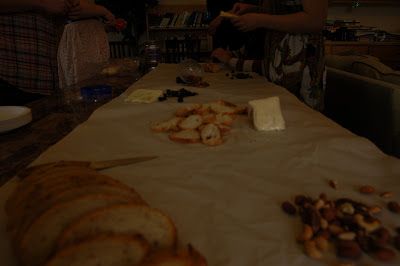
I didn't know until my student Tiana wrote this blog post that bottling grape juice is a Utah tradition. I had my first experience harvesting and bottling grape juice from my garden this fall, and it was luscious. The beautiful and talented Slade sisters each wrote a post about their long-standing family tradition of making grape juice--these are some of my favorite student writings about family food traditions.
Here's Tiana's:One of my family’s biggest traditions is making grape juice every fall. We enjoy growing, tending and juicing the grapes together, and the outcome is delicious.
The grape vines are almost magical: the way they look so dead during the winter, then in the spring, the way the small pink buds emerge and shoot out furry red leaves, that over the following days turn green and fan out. And watching the grapes start out as little green specks, and turning into juicy purple Concord grapes is really is fun.
Our vineyard was planted when my mother was about 12 years old. She was born and raised in the same house that I live in now, and you can tell that she loves keeping the family tradition that she spent a lot of her time growing up with. We even have bottles of grape juice from when my mother's family first started bottling it, but it's all pink now, and nobody dares to drink it.
This tradition brings our family closer together. Picking grapes in the cold nips at any bare skin. Helping each other and keeping each other company and taking everything you got that day into the warm house where the stove is turned on. De-stemming the grapes while sipping the fresh hot grape juice just out of the steamer. It is a great thing to look forward to in the fall, and I love being able to enjoy our hard work all year round when we open up a bottle months later.
Anyway, I think that traditions are an important part of growing up and bonding with your family. It is never too late to start traditions.
Have fun!
Here's Ella's:
Wool gloves, stained from last year's session, in an effort to keep your hands warm in the frost.
Boots muddy from the soft ground
covered with light ice crystal sprinkled over the brown.
Dry leaves and luscious, plump, drooping grapes, ready for what they were planted for.
Cold bitter wind biting at your ears and nose, quickly snapping vines, work steadily.
The smell of Kool-aid fills the room, steam mingling with overflow from the crack of the lid. Moist and sweaty.
Plucking the delicate fruit from their stem, rinsing in the sink, the dust and spider webs come clean from their skin, ready to be loved by a new sort.
Sweating contently, liquefaction.
Time and effort, love and passion.
Dreaded and impatient, awed and amazed.
Mixed feelings tingle through our blood, unsure of how the experience will turn out with the season.
Mason jars, patterned perfectly,
translucent circles cover the floor, being filled with the joys of the year,
overlapping attention,
opaque with thick royal purple,
dense with pure lovin’.
.JPG)
.JPG)
























